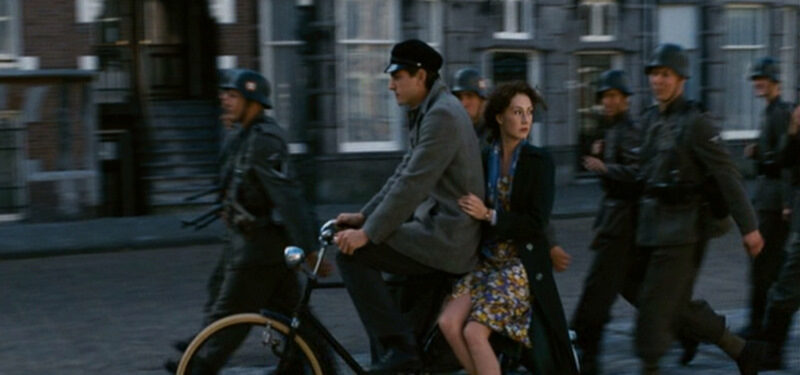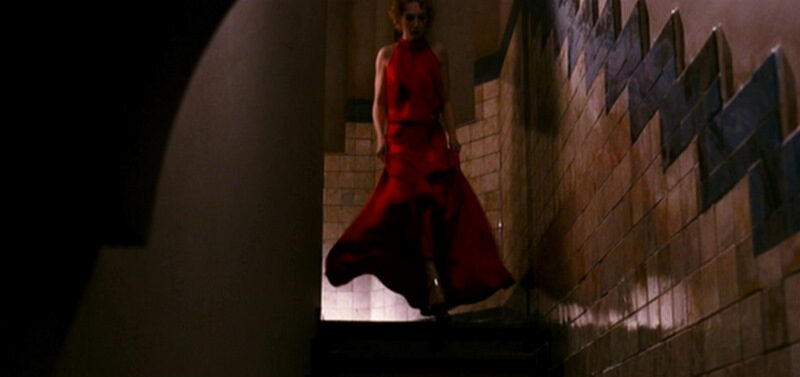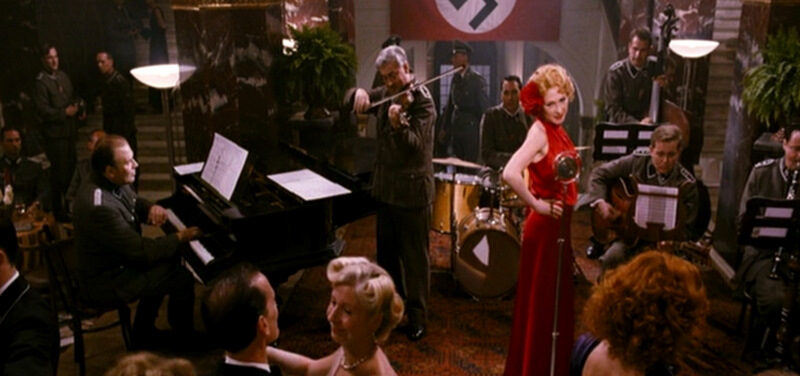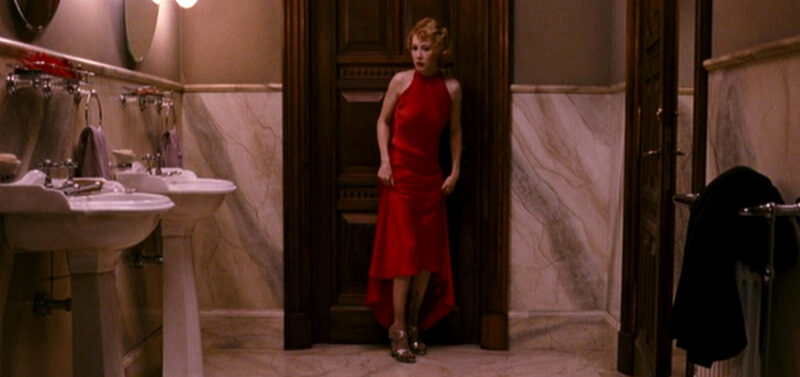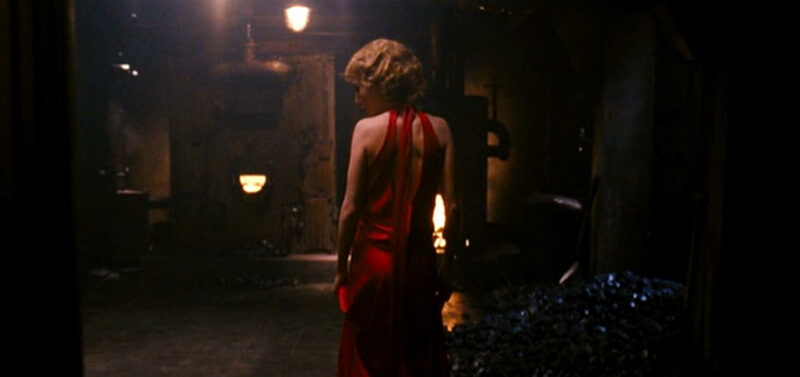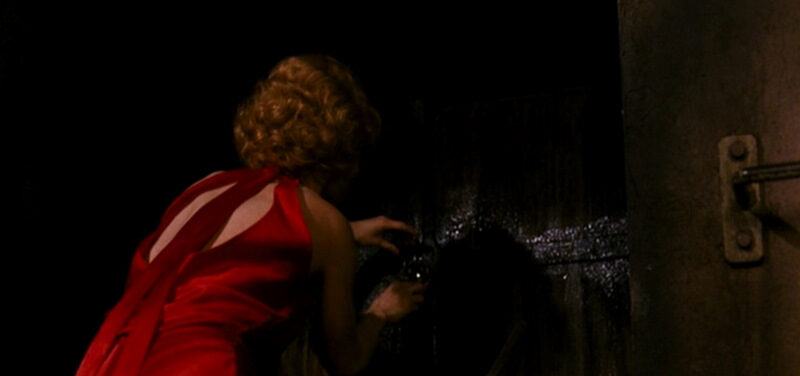Carice van Houten in Black Book: The Red Dress | Clothes on Film
© 2010, Clothes on Film 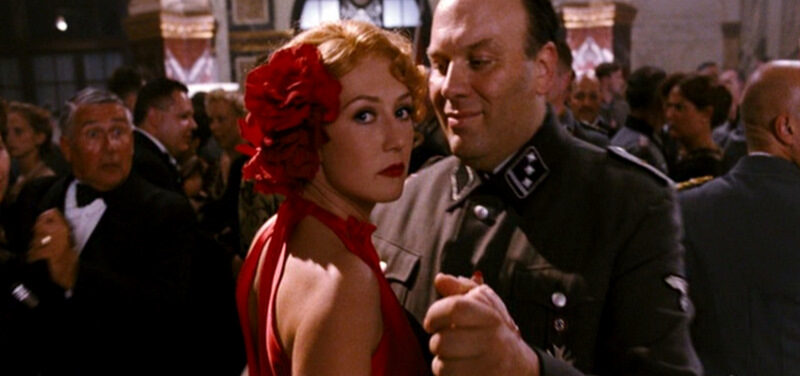
21 Sep ’10 Filed under Clothes from 1940s, Girls in Films. Tagged Black Book red dress, Carice van Houten, costume, De vierde man, Diane Kruger, evening dress, gown, halterneck, identity, Jacques Fath, narrative, National Treasure, Nina Ricci, Paul Verhoeven, silk, slingback shoes, The Fourth Man, World War II, Yan Tax. Bookmark the permalink. Post a comment. Leave a Trackback (URL).
There are many eye-popping moments in Black Book (2006), aka Zwartboek, though probably the most PG friendly is when Carice van Houten transforms into a Resistance beauty of Jean Harlow-esque proportions wearing an unmissable red halterneck dress.
Black Book is a World War II set action thriller directed Paul Verhoeven. Based on true events it charts the story of Ellis de Vries (formally Rachel Stein) played by Carice van Houten, a Jewish singer who joins the Dutch Resistance and then infiltrates the German Gestapo. Ultimately, however, the tide turns as she finds herself branded a traitor by her comrades and forced to go into hiding. It is unquestionably Verhoeven’s best film in years; quite simply a rollicking good yarn.
The noteworthy period costume design is by Yan Tax. Van Houten’s outfits vary considerably at different junctures in the story. At the start of her journey Ellis wears mainly flowery tea dresses with cap sleeves, very typically 1940s (the film is primarily set in 1944). Her look is as fresh and naïve as her outlook.
Following the murder of her family Ellis dies her hair platinum blonde as a disguise, while often donning a short trench coat or overcoat and beret. After Liberation she chooses a short leather driving coat and high waisted slacks; Ellis’ semblance becomes harder edged and her clothes seemingly more exclusive over time.
Ellis’ red silk evening dress is undoubtedly her most exclusive item of all. Worn in the context of the story at a party in honour of Hitler’s birthday, this luxurious gown would surely have been imported couture from Paris. Around ninety fashion houses remained open during the occupation in France, including names such as Jacques Fath and Nina Ricci. The Germans placed restrictions on export (something designers often flouted on purpose with outlandish creations using precious materials), though conversely they were still keen on selling to other occupied nations.
The German ministry of propaganda paid for fashion shows as a way to encourage sales. Most haute couture never left France as it was only wealthy Parisians who could afford to buy it, yet there were still some shows held in the Netherlands. Presumably Ellis’ sponsors in the resistance chipped in to buy this particularly expensive looking dress for her. Symbolic and arresting to behold, it is a dramatic and highly visible piece of costume design:
Full length evening dress in red silk; unfitted bodice, draped to the waist with a halterneck gathered above the chest and tied in a false knot at the back of the neck with a single tie left loose between a draped v-neckline; long flared skirt with fitted yoke at the natural waistline; worn with silver high-heel open toe slingback shoes and red rose flower hair clip.
The halterneck dress was popular in the 1930s because the priority area of display had shifted from the legs, in the twenties, to the back. Its popularity continued into the forties and it remains the template for most evening gowns today. Thanks to Roy Halston’s crucial revival during the disco era of the late seventies, the halterneck shall forever be associated with nightime grandeur.
Ellis’ dress is complicated in construction, though understated by minimal use of accessories. Nonetheless it is prioritised on screen as more than a pretty costume; there is subtext beneath the glamour. The colour is obviously a striking choice, its meaning generally comprising ‘sin’, ‘danger’ and ‘traitor’. Paul Verhoeven has used this colour on a central female character before in his film The Fourth Man (De Vierde Man, 1983). It is a deliberately distracting presence, a facet that Verhoeven employs to reflect the predicament of his protagonist.
As a means of disrupting the implied meaning of the dress and outfit as a whole, Ellis chooses to wash coal off her pristine shoes in a toilet bowl. Moreover when she opens the coaling hatch to let the resistance into Gestapo HQ, Verhoeven lingers on her dress and shoes with several close ups. He draws direct attention to the exquisitely beautiful and, in the context, absurd nature of her ensemble by contrasting it with the dark, filthy world it inhabits.
This is another ‘dress for action’ similar to Diane Kruger’s ball gown in National Treasure (see HERE), one that becomes most interesting when separated from its natural environment. It could be debated that the dress is too special and too distracting. Presumably a spy would want to remain as inconspicuous as possible? Though to counter this argument there is always the idea of hiding in plain sight – clearly one that Ellis was employing here.
A knowingly conspicuous garment, Carice van Houten’s red dress is as visually excessive as Black Book itself. Paul Verhoeven is clearly a director who fully appreciates the use of costume design in his movies.
© 2010 – 2011, Chris Laverty.
Related Posts:
